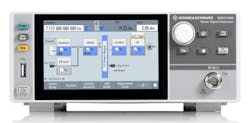Test and measurement for broadband transponders on New Space satellites introduced by Rohde & Schwarz
MUNICH – Test and measurement specialist Rohde & Schwarz in Munich is introducing the Rohde & Schwarz SZV100A RF upconverter for testing broadband transponders in the payloads of very high throughput satellites (VHTS).
With its 2 GHz modulation bandwidth, the Rohde & Schwarz SZV100A covers the frequency range from 36 GHz to 56 GHz, which offers large bandwidths for feeder links to satellites, making it ideal for the implementation of upcoming data links with high bit rates.
This includes future communications and cellular backhaul networks that can provide end users with large volumes of data, such as operators of conventional geostationary satellites as well as low-Earth orbit (LEO) satellites in the New Space environment.
High demands are placed on microwave components in the Q/V band, which means they must undergo extensive testing during development and verification. Amplifiers, converters, receiver modules, and complete satellite payloads are just a few examples of components that must be tested in the Q/V band.
Related: Building readiness through test and measurement
Especially for satellite payloads, test equipment must meet high requirements for signal quality. The Rohde & Schwarz SZV100A Q/V band RF upconverter provides continuous coverage of all satellite bands from VHF to V band as well as the frequency bands for 5G in the Q/V band.
The test setup for broadband transponders consists of the Rohde & Schwarz SMW200A vector signal generator, SMA100B RF and microwave signal generator, and the SZV100A Q/V band RF upconverter. The SMW200A delivers the modulated broadband IF signal with bandwidths to 2 GHz, while the SMA100B provides the high-precision LO signal. The maximum output power of the SZV100A is as high as +16 dBm (at 1 dB compression point).
The compact housing design, low weight, and mounting points of the SZV100A allow mounting as close as possible to the device under test, for example on the outside of a thermal vacuum chamber. The distance between the IF source or LO source and the SZV100A can be as long as 10 meters.
Users can operate the upconverter and the signal generators remotely with PC software over a LAN connection. For more information contact Rohde & Schwarz online at www.rohde-schwarz.com.
